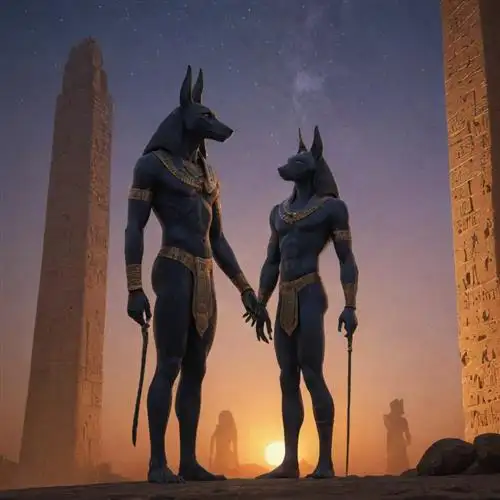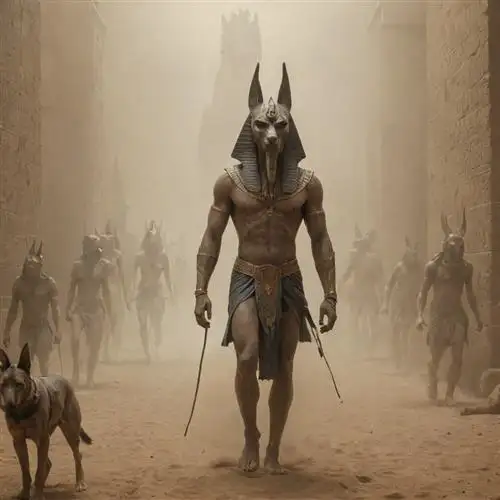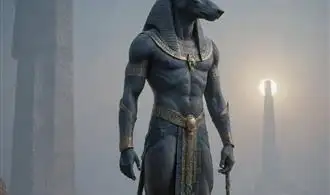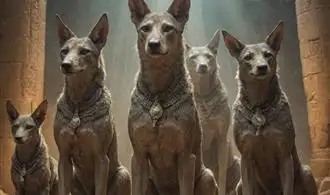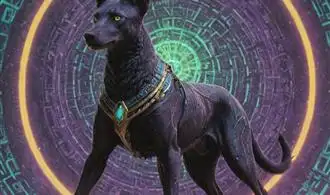
The Iconic Representation of Anubis
The iconic representation of Anubis, the ancient Egyptian jackal-headed deity, has long held a captivating allure for scholars and enthusiasts alike. As one of the most prominent figures in the Egyptian pantheon, Anubis' visual depictions offer a wealth of insights into the beliefs, rituals, and symbolic significance surrounding this enigmatic god.
At the heart of Anubis' iconography is the jackal or canine head, which is believed to have been chosen for its association with the desert and the underworld. Jackals were often observed near burial sites, scavenging the dead, and this connection with the realm of the dead made the jackal an apt choice for the god responsible for the embalming and protection of the deceased. The stark contrast between the human body and the animalistic head serves to emphasize Anubis' role as a mediator between the earthly and the divine realms.
Beyond the jackal head, Anubis is often portrayed holding various ritual objects, such as the crook and flail, which were symbols of kingship and authority in ancient Egypt. The god may also be depicted with other sacred implements, like the funeral canopic jars or the scales used to weigh the deceased's heart against the feather of Ma'at, the goddess of truth and justice. These visual cues not only establish Anubis' role as the guardian of the dead but also hint at the complex web of beliefs and practices surrounding the afterlife in ancient Egyptian culture.
Interestingly, the color of Anubis' skin is also a subject of scholarly debate. While the traditional depiction shows the god with black skin, some scholars suggest that this may have been a symbolic representation of the color of the mummified body or the rich, fertile soil of the Nile Valley. Alternatively, the black color may have been chosen to evoke the dark, mysterious qualities associated with the underworld and the processes of death and rebirth.
In some instances, Anubis is shown in a more composite form, with the body of a human and the head of a jackal. This hybrid representation likely served to highlight the god's dual nature, as both a divine being and a psychopomp – a guide for the souls of the deceased on their journey to the afterlife. The interplay between the human and animal elements within Anubis' iconography underscores the complex and multifaceted nature of this ancient deity.
Anubis and the Mummification Process
Anubis, the Egyptian jackal-headed god, played a pivotal role in the mummification process, which was integral to the ancient Egyptian belief in the afterlife. As the god associated with embalming and the preparation of the dead for the journey to the afterlife, Anubis's presence is woven throughout this sacred ritual.
The mummification process was a meticulous and intricate procedure that involved the removal of internal organs, the desiccation of the body, and the careful wrapping of the deceased in linen bandages. Anubis oversaw each step of this complex process, ensuring the proper preservation of the body and the protection of the soul.
One of Anubis's primary responsibilities was the removal of the internal organs, which were considered impure and were typically placed in canopic jars. The brain, often considered the seat of intelligence, was typically removed through the nose and discarded, as the ancient Egyptians believed it held no significance in the afterlife.
Anubis also presided over the desiccation of the body, a process that involved packing the body with natron, a naturally occurring salt. This step was crucial in removing moisture from the body, preventing the growth of bacteria, and preserving the physical form of the deceased.
After the internal organs were removed and the body was desiccated, Anubis oversaw the wrapping of the body in linen bandages. This process was not only practical, but also symbolic, as the bandages were believed to protect the deceased and facilitate their journey to the afterlife.
Anubis's role in the mummification process extended beyond the physical preparation of the body. He was also responsible for guiding the soul of the deceased through the challenges of the afterlife, ensuring their safe passage to the realm of the gods.
Anubis as a Guide to the Underworld
Anubis, the jackal-headed Egyptian deity, holds a profound significance in the realm of ancient Egyptian mythology. As a guide to the underworld, Anubis played a vital role in the journey of the deceased, shepherding them through the afterlife and ensuring their successful transition to the next realm.
At the heart of Anubis' role as a guide to the underworld lies his deep connection to the process of mummification and the preservation of the dead. As the god associated with embalming and the preparation of the body for the afterlife, Anubis was responsible for overseeing the intricate rituals and rites that were essential for the deceased to navigate the treacherous passage to the afterlife.
One of the most significant aspects of Anubis' role as a guide to the underworld is his involvement in the pivotal moment of the "Weighing of the Heart" ceremony. During this ceremony, the deceased's heart was weighed against the feather of Ma'at, the goddess of truth and justice. Anubis, as the overseer of this process, played a vital role in determining the fate of the soul. If the heart was found to be "light" and in harmony with the principles of Ma'at, the deceased would be granted passage to the afterlife. If the heart was "heavy" with sins or transgressions, the soul would face a grim fate, often being devoured by the fearsome entity known as the Devourer.
Anubis' presence in the underworld was not limited to the Weighing of the Heart ceremony; he was believed to accompany the deceased on their journey through the various realms and obstacles that lay between the mortal world and the afterlife. His guidance was crucial in ensuring the safe passage of the soul, as he navigated the treacherous pathways, guarded the gates, and protected the deceased from the malevolent forces that lurked in the underworld.
Moreover, Anubis' role as a guide to the underworld was not merely a practical one; it was also deeply symbolic. As the god associated with death and the afterlife, Anubis represented the transition from life to death, and his presence offered comfort and reassurance to the deceased and their loved ones. His jackal-headed form, with its acute senses and keen instincts, symbolized the ability to traverse the unknown and guide the soul through the mysteries of the afterlife.
Anubis in Egyptian Funerary Art and Artifacts
Anubis, the jackal-headed Egyptian deity, held a significant role in the funerary rites and artifacts of ancient Egypt. As the god of embalming and the afterlife, Anubis' presence is ubiquitous in the rich tapestry of Egyptian funerary art and artifacts. Unraveling the hidden meanings behind these depictions offers profound insights into the beliefs and practices of this ancient civilization.
Anubis' iconic image is a testament to his importance in the funerary rituals of ancient Egypt. The jackal-headed figure is often depicted performing the embalming process, guiding the deceased through the perilous journey to the afterlife. In tomb paintings and reliefs, Anubis is shown standing guard over the mummification process, ensuring the proper preservation of the body. This symbolic role underscores the belief that Anubis was the protector of the dead, responsible for the successful transition from this life to the next.
Funerary artifacts, such as canopic jars and funerary stelae, also feature prominent depictions of Anubis. Canopic jars, which housed the internal organs of the deceased, were often adorned with the head of Anubis, symbolizing his role in the preservation of the body. Funerary stelae, or commemorative stone slabs, frequently included images of Anubis guiding the deceased through the afterlife, reinforcing his position as a psychopomp, or conductor of souls.
The ubiquity of Anubis in Egyptian funerary art and artifacts extends beyond his direct representations. The jackal, Anubis' animal form, is often incorporated into various funerary objects, such as coffins, amulets, and funerary masks. These symbolic associations serve to invoke the protective and transformative powers of Anubis, ensuring the deceased's safe passage to the afterlife.
Moreover, the placement and positioning of Anubis in funerary art and artifacts hold great significance. In tomb paintings, Anubis is often depicted in a central or prominent position, emphasizing his pivotal role in the funerary rituals. The orientation of Anubis' figure, whether facing the deceased or guarding the entrance to the tomb, conveys the specific purpose and meaning behind the artistic representation.

